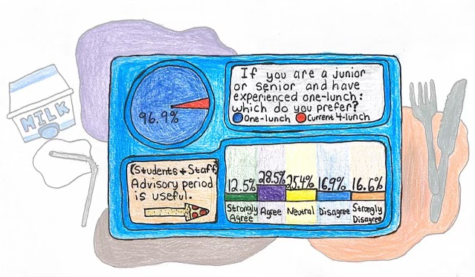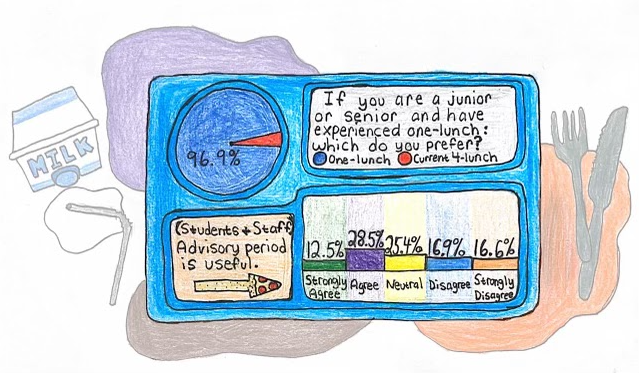What are student and staff opinions on the new lunch schedule and e-hall pass?
October 19, 2021
PA student and staff opinions on the lunch schedule and e-hall pass
Junior Vikram Kolli is a part of the 34.7 percent of student respondents to a recent Page survey, who do not think advisory period is useful. This 25-minute period was originally built into the schedule as a monthly opportunity to facilitate real-world discussions and activities. However, having it daily this year has caused advisory to become more of a free period-study hall hybrid.
According to Kolli, “The period is meaningless and should be used to lengthen lunch times because the duration of lunch is too short.”
Responses from the survey provide more insight into student and staff opinion on the new school guidelines, as we continue to transition into a post-COVID normal.
Senior Tori Loehn has a slightly different opinion regarding advisory period, as it provides time for her to “either finish homework before class, or finish class activities done during class. I do enjoy the fact that advisory is built in; however if it were to be eliminated due to the installment of one lunch again, I would be happier.”
Loehn contributes to the overwhelming 96.9 percent of juniors and seniors who prefer one lunch to the current lunch schedule. The four-lunch blocks require students this year to eat lunch at an assigned time, in their assigned locations, rather than have a 50-minute free lunch period.
One anonymous respondent truly embodies the passion upperclassmen have towards this subject: “BRING BACK ONE LUNCH.”
However, there is just as much fervor for the opposing side. This anonymous teacher respondent states: “I hate one lunch with the very pit of my soul. When people speak of it fondly, I make a mental note to see what they drive and slash their tires. I do not want to guard an exit two to three times per week or police ‘quiet hallways.’”
Another anonymous teacher respondent is more neutral on the topic, stating that they “liked many things about one lunch, especially the opportunities for students to get extra help and the ability to hold club meetings. I do think that one lunch needed more structure, though.”
Band director John Boyd echoes this comment, recalling one lunch as “being borderline chaos.”
Another change this year, the new e-hall pass system, is viewed as a loss of instructional time by several teachers. As simply explained by an anonymous respondent, “I have to stop what I am doing, go to my computer, log in to e-hall pass, approve a student’s request, and do the same when they return. All of that requires me to stop instruction.”
This opinion aligns with that of the 39.8 percent of student respondents who strongly disagree with the statement: the e-hall pass is easier to use than traditional hall passes.
While these new school guidelines were introduced in response to COVID-19, the length of their implementation moving forward is still unknown. With mixed reactions from students and teachers alike, will the sense of normalcy brought by monthly advisory periods, one-lunch, and traditional hall passes ever return?
Data on lunch and e-hall pass opinions
Out of the 274 PA students who responded to a recent survey conducted by The Page, 68 percent find the e-hall pass more difficult to use than traditional hall passes. However, teachers are relatively split.

Students and teachers also differed on their opinions relating to one lunch. The majority of anonymous teacher responses expressed a collective dislike of their hall monitor duties during the 50-minute lunch period, while only 3.1 percent of juniors and seniors prefer the current four-lunch schedule.
Twenty-nine percent of students agree that the daily advisory period is useful. However, 17.5 percent strongly disagree, and 17.2 disagree. In response to whether teachers have set advisory periods, a majority of students stated that they used advisory mainly as a study block.
For the student and staff populations, the margin of errors are ±5.45 and ±18.7 percentage points respectively.

